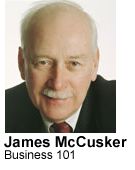 |
|
|
YOUR
COUNTY.
|
YOUR
BUSINESS JOURNAL.
|
Published November 2004
When
analyzing resumes,
read for speed, need
 If
you want to learn how to write a resume, there are all sorts of books,
software, Web sites and seminars to help you. If you want to learn how
to read a resume, though, you’re pretty much on your own.
If
you want to learn how to write a resume, there are all sorts of books,
software, Web sites and seminars to help you. If you want to learn how
to read a resume, though, you’re pretty much on your own.
It is an acquired skill, certainly. The first few seem to take forever, and it remains an extremely time-consuming process even after we get the hang of it.
The first basic technique you need to learn in order to survive the resume reading process is to read for speed.
Reading for speed is driven by equal parts of efficiency and survival. Modern market economies seem to promote employment turbulence. And this, combined with the improved communications of our time, can result in a startling level of response to routine job openings. Placing an advertisement in the job classifieds today often puts an employer directly in the path of an avalanche of resumes.
Few organizations can afford to bring their operations to a halt so that each of those resumes can be pored over, word by word. To bring in the best candidate, you need to find a way to deal with the mountain of paper accumulating on your desk. And that means setting priorities.
Once you have read a few hundred, or maybe a thousand, resumes, you begin to realize how important the “objective” statement and the cover letter are. Everybody who sends in a resume is looking for a job. We already know that. But the objective stated in the resume tells us what kind of work the person is looking for, and why.
And, along with the cover letter, these relatively brief portions of the resume tell us a lot about how he or she will approach the job. Ahead of anything else in the resume, they communicate two fundamental things: what kind of person this is and what kind of work he or she wants.
In the process of telling us about the candidate, cover letters and objective statements are also key elements of the “read for speed” technique, for they allow us to move quickly through a stack of resumes, separating the ones that are worth more attention from the ones that can safely be ignored.
Woods and Associates LLC, a Seattle human resources firm, often takes on the task of screening resumes for clients who find themselves snowed under by the sheer volume of applicants. Marya Granger-O’Neil, one of the firm’s specialists, has considerable experience with this, and says, “First, we check the cover letter to see if it says why they can do the job and why they want to work for that particular company. In a set of 200 resumes, you can usually eliminate half of them by setting aside those with cover letters addressed to the wrong person, those with glaring grammatical and spelling errors, and those with other characteristics that indicate gross carelessness. If they are that careless with their resume, they will probably perform the same way on the job.”
Dawn Johnson is also an experienced specialist with Woods and Associates. She says, “One of the things we look for in a cover letter is an indication that the applicant knows something about the organization they are applying to work with. A good cover letter should answer the question: Why do you want to work for that particular organization?”
She seconds Granger-O’Neil’s view that a lot of resumes don’t make the cut because of spelling and grammatical errors. She adds that “often, it is the applicants who claim ‘attention to detail’ as one of their employment qualifications whose cover letters and resumes are riddled with errors.”
Staying close to the read for speed technique — concentrating first on cover letters, objectives and evidence of carelessness — can, in most cases, reduce the size of the stack by 80 percent. This allows us to get the best out of the surviving resumes, by switching to a different technique, read for need.
You need someone to fill a specific position, and as you read a resume, try to imagine the person described in it actually doing the job. There are all sorts of wonderful people in this country, and their resumes can make compelling reading. But just because a candidate has a Super Bowl ring, or once played Texas Hold’em professionally, doesn’t mean that he or she would make a good operations manager for you. Stay focused on the job requirements and each candidate’s ability to meet them.
Selecting a candidate to fill a position in your organization is a crucial decision, one of a handful of such decisions that a manager cannot afford to get wrong. So, read for speed, read for need and then use your very best judgment.
James McCusker, a Bothell economist, educator and small-business consultant, writes “Your Business” in The Herald each Sunday. He can be reached by sending e-mail to otisrep@aol.com.
© 2004 The Daily Herald Co., Everett, WA








